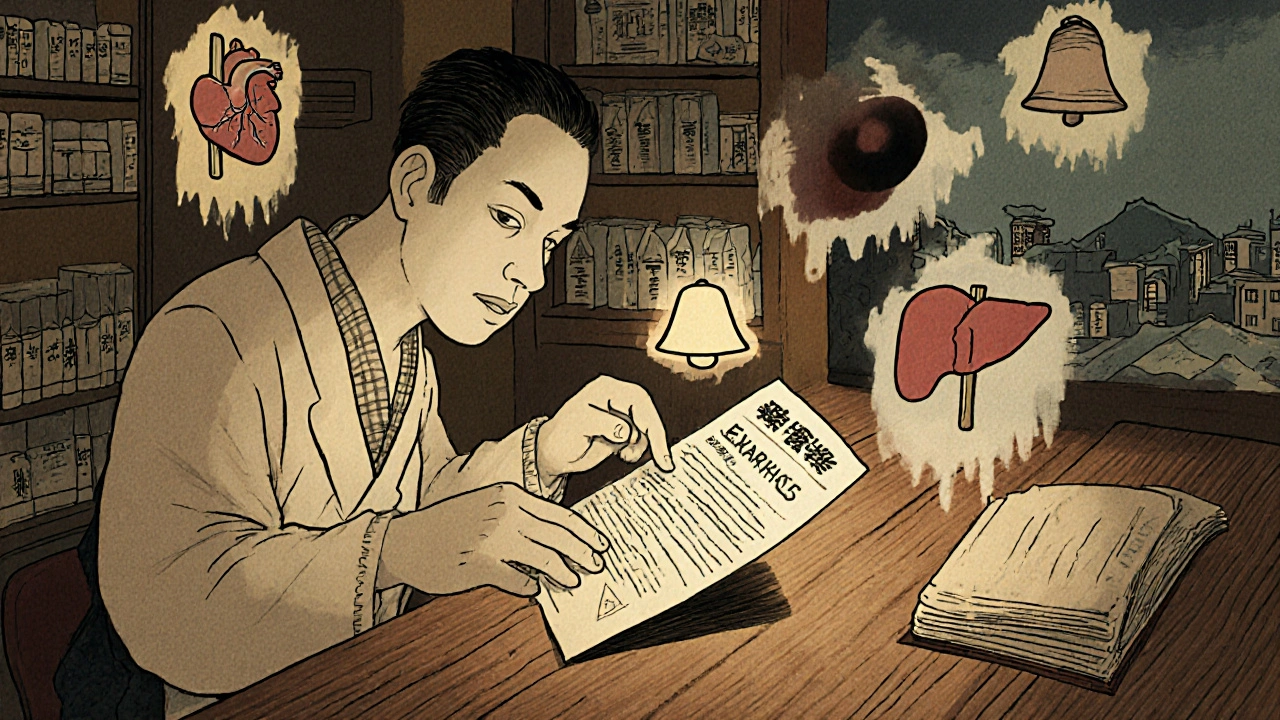
Frequency to Real-World Patients Calculator
How Common Is This Side Effect?
This tool helps you understand what frequency terms like "rare" or "uncommon" actually mean for real patients. Based on FDA drug label standards, we convert these categories into concrete numbers.
Estimated Impact
In a population of 10,000 patients, you might expect 10 cases of this side effect.
This means that out of 10,000 patients taking this drug, about 10 people could experience this side effect based on FDA reporting standards.
Why This Matters
Remember: "Rare" doesn't mean "harmless." A "very rare" side effect reported in just one patient can be life-threatening. This calculator shows how frequency terms translate to real-world numbers so you can better understand the information in drug labels.
When you pick up a new prescription, the prescribing information that comes with it isn’t just a list of instructions. Hidden in Section 6 is a part most people skip - the postmarketing experience section. This isn’t marketing fluff. It’s the FDA’s way of telling you what’s happened to real people after the drug left the clinical trial and entered the real world. And if you don’t understand what it means, you could be missing critical safety signals.
What Exactly Is Postmarketing Experience?
Postmarketing experience refers to adverse reactions reported after a drug has been approved and is being used by hundreds of thousands, sometimes millions, of patients. Before approval, drugs are tested in controlled trials with a few hundred to a few thousand people. That’s not enough to catch rare side effects. Maybe one in 10,000 patients gets a dangerous reaction. In a trial of 5,000 people, that might never show up. But once the drug is on the market, those rare reactions start appearing - and the FDA requires drug makers to report them.This section is part of the Full Prescribing Information (FPI), which is the official document doctors and pharmacists use to understand a drug’s risks. It’s not optional. It’s required by federal law under 21 CFR 314.80. The FDA doesn’t wait for proof. If a serious reaction is reported even once, and it wasn’t seen in trials, it goes into this section. That’s why you’ll see phrases like “reported cases” or “isolated reports.” These aren’t warnings to ignore - they’re red flags that something unusual is happening.
Why This Section Matters More Than You Think
A 2022 analysis by the Institute for Safe Medication Practices found that 62% of serious drug reactions identified between 2010 and 2020 were first noticed after the drug hit the market. That’s not a small number. It means more than half of the worst side effects weren’t caught in clinical trials. Think about that. A drug could be approved, prescribed widely, and only later do doctors realize it causes a rare but deadly heart rhythm problem - because it only showed up in 17 patients out of 2 million.One real case involved a new anticoagulant. Early reports called the bleeding events “isolated.” Doctors assumed they were accidents. But when 17 fatal hemorrhages piled up over six months, the pattern became undeniable. The label was updated. Patients were warned. Lives were saved - but only because someone finally looked at the postmarketing data closely.
The FDA’s Adverse Event Reporting System (FAERS) holds over 35 million reports as of 2023. That’s not just noise. It’s a live surveillance system tracking what drugs do in the wild. And it’s growing. The FDA’s Sentinel Initiative now monitors health data from over 300 million Americans. That’s not a lab. That’s real life - with real people, real comorbidities, real drug interactions.
How to Read the Language - and What It Really Means
The way side effects are listed in this section follows strict rules. They’re ordered by frequency: most common first. But here’s where people get tricked.Look at this example:
- Common (≥1/100): Nausea, headache
- Uncommon (≥1/1,000 to <1/100): Dizziness, fatigue
- Rare (≥1/10,000 to <1/1,000): Liver enzyme elevation
- Very rare (<1/10,000): Anaphylaxis - reported cases
That last line - “anaphylaxis - reported cases” - sounds like a footnote. But it’s not. It means at least one person had a life-threatening allergic reaction. That’s not theoretical. That’s someone’s emergency room visit. The phrase “reported cases” doesn’t mean it’s unlikely to be serious. It means the evidence isn’t strong enough to confirm it’s directly caused by the drug. But that doesn’t mean you should ignore it.
A 2021 study in Clinical Pharmacology & Therapeutics found that 78% of healthcare providers misread this language. They assumed anything listed only in the postmarketing section was less dangerous. That’s wrong. The severity isn’t tied to how often it’s reported. It’s tied to how bad the outcome is. One case of liver failure is more important than 100 cases of mild rash.

What’s Missing From the Label - And Why That’s Dangerous
Here’s something the FDA insists on including in every label since 2016: “The absence of a particular adverse reaction in this section does not mean the drug does not cause the reaction.”That’s a mouthful. But it’s critical. Just because your drug’s label doesn’t mention “kidney stones” doesn’t mean it can’t cause them. Maybe no one’s reported it yet. Maybe it’s too rare. Maybe doctors haven’t connected the dots. The label is a snapshot - not a guarantee.
Doctors and pharmacists are supposed to use this section as a starting point, not a finish line. The FDA’s 2023 guidance says you should ask four questions when evaluating any reported reaction:
- Did it happen after taking the drug? (Temporal relationship)
- Is there a biological reason it could happen? (Plausibility)
- Did it go away when the drug was stopped? (Dechallenge)
- Did it come back when the drug was restarted? (Rechallenge)
If the answer to at least two of these is yes - especially dechallenge - it’s worth taking seriously. That’s how rare side effects become recognized risks.
Why Clinicians Struggle With This Section
A 2022 AMA survey of 1,247 physicians found that 63% were confused about how to interpret the frequency data. Over 40% regularly assumed side effects listed only in postmarketing sections were less serious. That’s a dangerous assumption.One cardiologist on Reddit posted: “I’ve seen the same drug list the same reaction in both Sections 6.1 and 6.2 with different frequency estimates. Which one do I trust?” He’s not alone. Drug makers sometimes update labels slowly. Data from different sources (FAERS, registries, international reports) can conflict. And there’s no central database that automatically reconciles them.
Pharmacists report similar issues. On ASHP forums, users describe cases where “isolated reports” of QT prolongation were ignored - until a patient coded on the ward. The reaction was listed. But because it was rare and labeled as “reported,” it was overlooked.

What’s Changing - And What It Means for You
The FDA is moving fast. Starting January 2025, all drug labels must submit postmarketing data in a machine-readable format called SPL-ESD. That means AI tools will soon scan millions of reports automatically, flagging patterns humans might miss. Pilot programs are already predicting label changes with 83% accuracy - and doing it six to nine months faster.Why does this matter to you? Because soon, these sections won’t just be static text on a PDF. They’ll be dynamic. If a new safety signal emerges, the label could update within days - not years. Your doctor might get an alert. Your pharmacy might flag your prescription. The system is becoming proactive, not reactive.
And the cost? The Congressional Budget Office projects postmarketing safety monitoring will rise from $4.2 billion in 2023 to $7.8 billion by 2030. That’s not waste. That’s insurance. For every dollar spent, the FDA prevents thousands of hospitalizations and hundreds of deaths.
What You Should Do
You don’t need to be a doctor to understand this. But you do need to be curious.- When you get a new prescription, ask your pharmacist: “Are there any side effects listed here that weren’t in the clinical trials?”
- If you experience something unusual after starting a new drug - even if it seems minor - report it to the FDA through MedWatch. Your report could help someone else.
- Don’t assume rare = harmless. A reaction listed once could be the warning sign for thousands.
- If your doctor dismisses a side effect because “it’s not common,” ask: “Is it listed in the postmarketing section? If so, why?”
The goal isn’t to scare you. It’s to give you the tools to ask better questions. Drug safety isn’t a one-time approval. It’s an ongoing conversation - between patients, doctors, and regulators. And the postmarketing experience section? It’s the part of the conversation you can’t afford to skip.
Are side effects in the postmarketing section less serious than those in clinical trials?
No. The severity of a side effect is not determined by how often it appears in the label. A reaction listed as a rare “reported case” in the postmarketing section - like liver failure or anaphylaxis - can be just as serious as a common side effect listed in clinical trials. The difference is in how often it occurs, not how dangerous it is.
Why do some drugs list the same side effect in two different sections?
Some side effects are seen in both clinical trials and postmarketing use. They may appear in Section 6.1 (clinical trial data) with a frequency estimate, and again in Section 6.2 (postmarketing) with different wording like “reported cases.” This happens because postmarketing data comes from real-world reports, which are less precise than controlled trials. The label includes both to show the full picture - not to confuse you.
If a side effect isn’t listed, does that mean the drug won’t cause it?
No. The FDA requires labels to include the phrase: “The absence of a particular adverse reaction in this section does not mean the drug does not cause the reaction.” Just because something hasn’t been reported yet doesn’t mean it can’t happen. Rare reactions may take years to surface, especially in older adults or people with multiple health conditions.
What does “reported cases” mean on a drug label?
“Reported cases” means the reaction has been observed in patients after the drug was approved, but there isn’t enough evidence to confirm it was directly caused by the drug. It could be a coincidence, or it could be a true side effect. The phrase signals caution - not dismissal. Even one case of a serious reaction like stroke or heart attack warrants attention.
Can I report a side effect myself?
Yes. The FDA’s MedWatch program allows patients, caregivers, and healthcare providers to report adverse events directly. You can submit a report online or by mail using Form 3500. Your report helps the FDA detect new safety patterns. Even if you’re unsure whether the drug caused the reaction, report it. The system is designed to collect all possible signals.


